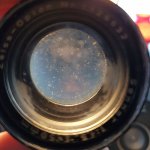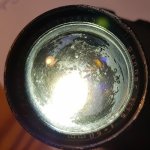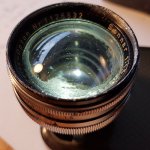I would say it's neither fungus nor decementing nor coating delamination due to improper cleaning methods but
water damage (leading to heavy coating damage and internal haze, and, probably, corroded aperture blades).
It can probably be salvaged. Best case, you end up with an uncoated front element (you can remove all the coatings with some Flitz or some Miror and some cotton balls without etching the glass, then you carefully clean the front element with dishwashing soap, tap water and your fingers). Worst case, the cemented groups are getting opaque and cannot be cured. Worst of the worst case, the aperture blades can break because of the corrosion.
The condition of the rear element surface and of the rear group optics will tell it all. Coating damage, even if heavy, as well as slight scratches at the front element can be turned out with a good cleaning and a good lens hood. A damaged rear element surface, or damaged rear group optics, often mean a ruined lens. The condition of the middle group will have some effects on the results too but the condition of everything being between the aperture blades and the film is what will make it.
Of course it has to be taken apart in full before you tackle any cleaning job and yes, Mike Elek's instructions are very good, the postwar f/1.5 Sonnar is built like the postwar f/2 Sonnar so you take it apart and reassemble it the same way.
See also :
http://elekm.net/zeiss-ikon/repair/collimate/




